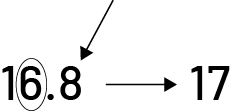B1.8 Round decimal numbers to the nearest whole number in various contexts.
Skill: Rounding Decimal Numbers to the Nearest Whole Number in Various Contexts
In most everyday situations, it is not necessary to work with a precise number, since an approximation is just as valid and often more convenient. Students in the junior grades need to be able to round using their number sense, which requires analysis and reflection.
Unfortunately, rounding is too often taught using methods that are meaningless because they deal with numbers and not quantity. For example, to round a decimal number to the nearest whole number, students are taught to identify the digit in the position to be rounded and then consider the digit that follows it. If it is greater than or equal to 5, the identified digit is increased by one and the digits that follow are eliminated.
Example

Source: translated from Guide d'enseignement efficace des mathématiques de la 4e à la 6e année, Numération et sens du nombre, Fascicule 3, Nombres décimaux et pourcentages, p. 42-43.
Research findings indicate that these traditional rounding methods do not develop the student's concept of rounding.
Note: Since rounding a decimal number requires students to use their decimal number sense, it is important that they have had the opportunity to develop it by representing decimal numbers, placing them on a number line and comparing them.
Example
To round 6.2 to the nearest whole, students recognize that 6.2 is a quantity equivalent to "6 and a bit more". They then know that the number is between 6 and 7. They then use their number sense to determine whether 6.2 is closer to 6 or 7. For example, students can use a benchmark number representing the middle of the range (6.5), "see" that 6.2 is close to 6, or even visualize the location of 6.2 on a number line.

Regardless of which element of the number sense is chosen, students are then able to round 6.2 to 6.
Source: translated from Guide d'enseignement efficace des mathématiques de la 4e à la 6e année, Numération et sens du nombre, Fascicule 3, Nombres décimaux et pourcentages, p. 44.
